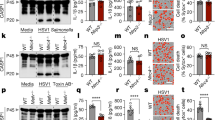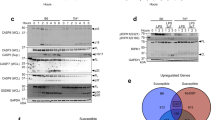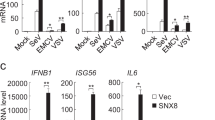Abstract
NOD2 receptor and the cytosolic protein kinase RIPK2 regulate NF-κB and MAP kinase signaling during bacterial infections, but the role of this immune axis during viral infections has not been addressed. We demonstrate that Nod2−/− and Ripk2−/− mice are hypersusceptible to infection with influenza A virus. Ripk2−/− cells exhibited defective autophagy of mitochondria (mitophagy), leading to enhanced mitochondrial production of superoxide and accumulation of damaged mitochondria, which resulted in greater activation of the NLRP3 inflammasome and production of IL-18. RIPK2 regulated mitophagy in a kinase-dependent manner by phosphorylating the mitophagy inducer ULK1. Accordingly, Ulk1−/− cells exhibited enhanced mitochondrial production of superoxide and activation of caspase-1. These results demonstrate a role for NOD2-RIPK2 signaling in protection against virally triggered immunopathology by negatively regulating activation of the NLRP3 inflammasome and production of IL-18 via ULK1-dependent mitophagy.
This is a preview of subscription content, access via your institution
Access options
Subscribe to this journal
Receive 12 print issues and online access
$209.00 per year
only $17.42 per issue
Buy this article
- Purchase on Springer Link
- Instant access to full article PDF
Prices may be subject to local taxes which are calculated during checkout








Similar content being viewed by others
References
Kilbourne, E.D. Influenza pandemics of the 20th century. Emerg. Infect. Dis. 12, 9–14 (2006).
Taubenberger, J.K. & Morens, D.M. 1918 Influenza: the mother of all pandemics. Emerg. Infect. Dis. 12, 15–22 (2006).
de Jong, M.D. et al. Fatal outcome of human influenza A (H5N1) is associated with high viral load and hypercytokinemia. Nat. Med. 12, 1203–1207 (2006).
Kobasa, D. et al. Aberrant innate immune response in lethal infection of macaques with the 1918 influenza virus. Nature 445, 319–323 (2007).
Perrone, L.A., Plowden, J.K., Garcia-Sastre, A., Katz, J.M. & Tumpey, T.M. H5N1 and 1918 pandemic influenza virus infection results in early and excessive infiltration of macrophages and neutrophils in the lungs of mice. PLoS Pathog. 4, e1000115 (2008).
Tumpey, T.M. et al. Characterization of the reconstructed 1918 Spanish influenza pandemic virus. Science 310, 77–80 (2005).
Guillot, L. et al. Involvement of toll-like receptor 3 in the immune response of lung epithelial cells to double-stranded RNA and influenza A virus. J. Biol. Chem. 280, 5571–5580 (2005).
Heer, A.K. et al. TLR signaling fine-tunes anti-influenza B cell responses without regulating effector T cell responses. J. Immunol. 178, 2182–2191 (2007).
Rehwinkel, J. et al. RIG-I detects viral genomic RNA during negative-strand RNA virus infection. Cell 140, 397–408 (2010).
Allen, I.C. et al. The NLRP3 inflammasome mediates in vivo innate immunity to influenza A virus through recognition of viral RNA. Immunity 30, 556–565 (2009).
Ichinohe, T., Pang, I.K. & Iwasaki, A. Influenza virus activates inflammasomes via its intracellular M2 ion channel. Nat. Immunol. 11, 404–410 (2010).
Thomas, P.G. et al. The intracellular sensor NLRP3 mediates key innate and healing responses to influenza A virus via the regulation of caspase-1. Immunity 30, 566–575 (2009).
Kanneganti, T.D. et al. Critical role for Cryopyrin/Nalp3 in activation of caspase-1 in response to viral infection and double-stranded RNA. J. Biol. Chem. 281, 36560–36568 (2006).
Martinon, F., Burns, K. & Tschopp, J. The inflammasome: a molecular platform triggering activation of inflammatory caspases and processing of proIL-beta. Mol. Cell 10, 417–426 (2002).
Schroder, K. & Tschopp, J. The inflammasomes. Cell 140, 821–832 (2010).
Mortimore, G.E., Hutson, N.J. & Surmacz, C.A. Quantitative correlation between proteolysis and macro- and microautophagy in mouse hepatocytes during starvation and refeeding. Proc. Natl. Acad. Sci. USA 80, 2179–2183 (1983).
Shi, C.S. et al. Activation of autophagy by inflammatory signals limits IL-1beta production by targeting ubiquitinated inflammasomes for destruction. Nat. Immunol. 13, 255–263 (2012).
Geisler, S. et al. The PINK1/Parkin-mediated mitophagy is compromised by PD-associated mutations. Autophagy 6, 871–878 (2010).
Sandoval, H. et al. Essential role for Nix in autophagic maturation of erythroid cells. Nature 454, 232–235 (2008).
Anand, P.K. et al. TLR2 and RIP2 pathways mediate autophagy of Listeria monocytogenes via extracellular signal-regulated kinase (ERK) activation. J. Biol. Chem. 286, 42981–42991 (2011).
Uhl, M. et al. Autophagy within the antigen donor cell facilitates efficient antigen cross-priming of virus-specific CD8+ T cells. Cell Death Differ. 16, 991–1005 (2009).
Cooney, R. et al. NOD2 stimulation induces autophagy in dendritic cells influencing bacterial handling and antigen presentation. Nat. Med. 16, 90–97 (2010).
Homer, C.R., Richmond, A.L., Rebert, N.A., Achkar, J.P. & McDonald, C. ATG16L1 and NOD2 interact in an autophagy-dependent antibacterial pathway implicated in Crohn′s disease pathogenesis. Gastroenterology 139, 1630–1641 (2010).
Kobayashi, K. et al. RICK/Rip2/CARDIAK mediates signalling for receptors of the innate and adaptive immune systems. Nature 416, 194–199 (2002).
Dugan, J.W. et al. Nucleotide oligomerization domain-2 interacts with 2′-5′-oligoadenylate synthetase type 2 and enhances RNase-L function in THP-1 cells. Mol. Immunol. 47, 560–566 (2009).
Sabbah, A. et al. Activation of innate immune antiviral responses by Nod2. Nat. Immunol. 10, 1073–1080 (2009).
Park, J.H. et al. RICK/RIP2 mediates innate immune responses induced through Nod1 and Nod2 but not TLRs. J. Immunol. 178, 2380–2386 (2007).
Ishikawa, H. et al. IFN-gamma production downstream of NKT cell activation in mice infected with influenza virus enhances the cytolytic activities of both NK cells and viral antigen-specific CD8+ T cells. Virology 407, 325–332 (2010).
Okamura, H. et al. Cloning of a new cytokine that induces IFN-gamma production by T cells. Nature 378, 88–91 (1995).
Kim, S. et al. Listeria monocytogenes is sensed by the NLRP3 and AIM2 inflammasome. Eur. J. Immunol. 40, 1545–1551 (2010).
Black, R.A., Kronheim, S.R., Merriam, J.E., March, C.J. & Hopp, T.P. A pre-aspartate-specific protease from human leukocytes that cleaves pro-interleukin-1 beta. J. Biol. Chem. 264, 5323–5326 (1989).
Lamkanfi, M. et al. Glyburide inhibits the Cryopyrin/Nalp3 inflammasome. J. Cell Biol. 187, 61–70 (2009).
Tsuchiya, K. et al. Involvement of absent in melanoma 2 in inflammasome activation in macrophages infected with Listeria monocytogenes. J. Immunol. 185, 1186–1195 (2010).
Sarkar, A. et al. ASC directs NF-kappaB activation by regulating receptor interacting protein-2 (RIP2) caspase-1 interactions. J. Immunol. 176, 4979–4986 (2006).
Nakahira, K. et al. Autophagy proteins regulate innate immune responses by inhibiting the release of mitochondrial DNA mediated by the NALP3 inflammasome. Nat. Immunol. 12, 222–230 (2011).
Saitoh, T. et al. Loss of the autophagy protein Atg16L1 enhances endotoxin-induced IL-1beta production. Nature 456, 264–268 (2008).
Travassos, L.H. et al. Nod1 and Nod2 direct autophagy by recruiting ATG16L1 to the plasma membrane at the site of bacterial entry. Nat. Immunol. 11, 55–62 (2010).
Joo, J.H. et al. Hsp90-Cdc37 chaperone complex regulates Ulk1- and Atg13-mediated mitophagy. Mol. Cell 43, 572–585 (2011).
Viala, J. et al. Nod1 responds to peptidoglycan delivered by the Helicobacter pylori cag pathogenicity island. Nat. Immunol. 5, 1166–1174 (2004).
Kobayashi, K.S. et al. Nod2-dependent regulation of innate and adaptive immunity in the intestinal tract. Science 307, 731–734 (2005).
Kash, J.C. et al. Genomic analysis of increased host immune and cell death responses induced by 1918 influenza virus. Nature 443, 578–581 (2006).
Rainsford, K.D. Influenza (“Bird Flu”), inflammation and anti-inflammatory/analgesic drugs. Inflammopharmacology 14, 2–9 (2006).
Netea, M.G. et al. Neutralization of IL-18 reduces neutrophil tissue accumulation and protects mice against lethal Escherichia coli and Salmonella typhimurium endotoxemia. J. Immunol. 164, 2644–2649 (2000).
Raeburn, C.D. et al. Neutralization of IL-18 attenuates lipopolysaccharide-induced myocardial dysfunction. Am. J. Physiol. Heart Circ. Physiol. 283, H650–H657 (2002).
Zhou, R., Yazdi, A.S., Menu, P. & Tschopp, J. A role for mitochondria in NLRP3 inflammasome activation. Nature 469, 221–225 (2011).
Hoffmann, E., Krauss, S., Perez, D., Webby, R. & Webster, R.G. Eight-plasmid system for rapid generation of influenza virus vaccines. Vaccine 20, 3165–3170 (2002).
Takeda, K. et al. Defective NK cell activity and Th1 response in IL-18-deficient mice. Immunity 8, 383–390 (1998).
Huang, G. et al. Signaling via the kinase p38alpha programs dendritic cells to drive TH17 differentiation and autoimmune inflammation. Nat. Immunol. 13, 152–161 (2012).
Kundu, M. et al. Ulk1 plays a critical role in the autophagic clearance of mitochondria and ribosomes during reticulocyte maturation. Blood 112, 1493–1502 (2008).
Acknowledgements
We thank members of the Veterinary Pathology Core lab at St. Jude for their work in processing of hematoxylin and eosin–stained and immunohistochemistry slides, members of the Cell and Tissue Imaging Core facility for their help in preparing and imaging transmission electron microscopy samples, and A. Coyle, E. Grant, J. Bertin (Millennium Pharmaceuticals), T. Mak (University of Toronto) and R. Flavell (Yale University) for providing mutant mice. M.L. is supported by grants from the EU Framework Program 7 (Marie-Curie grant 256432), European Research Council (grant 281600) and the Fund for Scientific Research Flanders (G030212N, 1.2.201.10.N.00 and 1.5.122.11.N.00). This work was supported by US National Institutes of Health grants (AR056296, AI101935 and CA163507) and the American Lebanese Syrian Associated Charities to T.-D.K.
Author information
Authors and Affiliations
Contributions
C.L. designed and conducted experiments, and wrote the manuscript. P.G.T. helped conduct the initial experiments in vivo in Ripk2−/− mice and helped design T cell experiments. P.K.A. conducted experiments with L. monocytogenes and helped write the manuscript. P.V. helped design experiments and interpret histopathology data. S.M. helped design and conduct experiments related to mitophagy and mitochondrial damage. J.M. helped design experiments related to mitophagy and mitochondrial damage. G.H. helped design and conduct experiments with Mapk14 conditional knockout mice. M.G. conducted experiments for IL-18, NF-κB and MAPK signaling. M.K. helped design experiments, and provided Ulk1−/− mice and other reagents for ULK1 experiments. H.C. helped design experiments and provided Mapk14 conditional knockout mice. R.J.X. helped design experiments and provided reagents for ATG16-related experiments and autophagy in general. D.R.G. helped design experiments and provided reagents for mitophagy-related experiments. M.L. helped design experiments and provided reagents for caspase-1 activation and interaction studies. C.A.D. helped design experiments and provided reagents for IL-18 neutralization studies. P.C.D. helped design experiments, provided reagents for T cell experiments and helped write the manuscript. T.-D.K. conceived project, designed experiments, analyzed data, helped write the manuscript and oversaw the project.
Corresponding author
Ethics declarations
Competing interests
The authors declare no competing financial interests.
Supplementary information
Supplementary Text and Figures
Supplementary Figures 1–8 (PDF 857 kb)
Rights and permissions
About this article
Cite this article
Lupfer, C., Thomas, P., Anand, P. et al. Receptor interacting protein kinase 2–mediated mitophagy regulates inflammasome activation during virus infection. Nat Immunol 14, 480–488 (2013). https://doi.org/10.1038/ni.2563
Received:
Accepted:
Published:
Issue Date:
DOI: https://doi.org/10.1038/ni.2563
This article is cited by
-
Paired protein kinases PRKCI-RIPK2 promote pancreatic cancer growth and metastasis via enhancing NF-κB/JNK/ERK phosphorylation
Molecular Medicine (2023)
-
The role of autophagy in viral infections
Journal of Biomedical Science (2023)
-
The mitophagy pathway and its implications in human diseases
Signal Transduction and Targeted Therapy (2023)
-
Epithelial IFNγ signalling and compartmentalized antigen presentation orchestrate gut immunity
Nature (2023)
-
MafB regulates NLRP3 inflammasome activation by sustaining p62 expression in macrophages
Communications Biology (2023)



